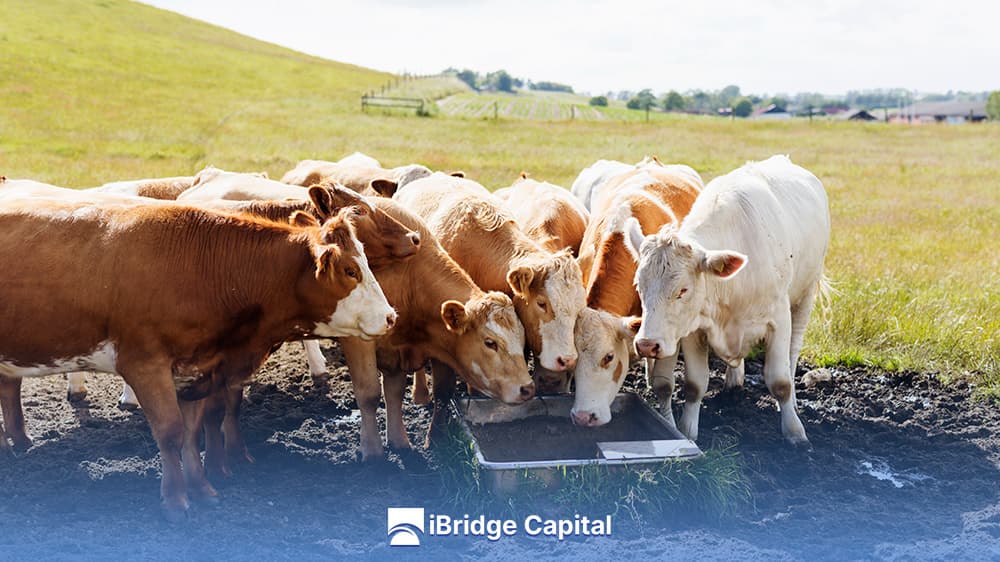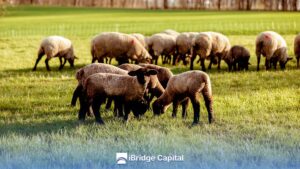Understanding Bloat: What It Is and Why It Happens
What is Bovine Bloat?
Bovine bloat, also known as ruminal meteorism or tympany, is one of the biggest concerns for producers who use legume pastures, especially alfalfa. Imagine a cow’s rumen as a large fermentation tank. When animals consume young, rapidly growing alfalfa, a large amount of gas is produced.
Under normal conditions, these gases are eliminated by belching. However, in the case of bloat, a persistent foam forms that traps these gases, preventing their release.
This gas accumulation creates excessive pressure in the rumen, which visibly distends the animal’s abdomen. It is an emergency condition that can progress very quickly, compromising the animal’s breathing and circulation.
Causes of Bloat in Cows
The causes of bloat in cows are multifactorial, but alfalfa is one of the main culprits. The problem arises primarily when animals consume very young, tender alfalfa with a high content of soluble protein and rapidly fermentable carbohydrates. These characteristics favor the formation of a stable foam in the rumen.
Frothy bloat in cattle is the most common type associated with alfalfa. It differs from free-gas bloat (which is due to a physical obstruction) in that here the gas is trapped in bubbles.
Factors such as dew, recent rain, or frost can increase the risk, as they alter the plant’s structure and the speed of consumption. Bloat from legumes like alfalfa is a constant challenge in high-production pasture systems.
Symptoms of Bovine Bloat
Recognizing the symptoms of bovine bloat is vital for early intervention. The signs can appear very quickly, sometimes within minutes or hours after the animals begin grazing on high-risk alfalfa. Other symptoms of bloat in cattle include:
- Restlessness and discomfort.
- Kicking at the abdomen.
- Difficulty breathing, with rapid, shallow breaths.
- Open mouth and tongue protrusion.
- Excessive salivation.
- Retching or unsuccessful attempts to belch.
In severe cases, the animal may collapse, lie down, and, unfortunately, die from asphyxiation due to pressure on the lungs and heart. Bloat and meteorism in cattle are terms often used interchangeably, but bloat specifically refers to the accumulation of foam.
Grazing Management: The Key to Prevention
The Ideal Time to Graze
Pasture management to avoid bloat is the most powerful tool you have as a producer. It’s not just about what you graze, but when and how you do it. The timing of grazing alfalfa to prevent bloat is crucial.
It is less risky to introduce animals to alfalfa pastures when the plant is more mature, ideally with 10-20% flowering. In this state, the alfalfa has more fiber and fewer frothing compounds.
Avoid grazing very young alfalfa, especially in the early morning when there is still dew or after a rain. Wet pastures and tender pastures are the most dangerous. It is preferable to wait for the pasture to dry and the dew to evaporate.
Some producers even opt for “pre-wilting,” which involves cutting the alfalfa a few hours before the animals enter, allowing for slight wilting.
Strip Grazing and Paddock Rotation
Paddock management to prevent bloat is a fundamental strategy. Strip grazing for bloat is a technique that limits animal access to a specific portion of the pasture for a set period. This prevents animals from selecting only the most tender parts and consuming large quantities at once. By forcing them to eat the plant more uniformly, the speed of intake and the likelihood of bloat are reduced.
Paddock rotation is also vital. Alternating alfalfa grazing with grass pastures helps to diversify the animals’ diet and reduce continuous exposure to high-risk legumes. Mixed pastures (alfalfa with grasses) are inherently less risky than pure alfalfa pastures. While alfalfa is an excellent crop, dietary diversity is always beneficial.
Feeding Strategies to Reduce Risk
A Balanced Diet for Prevention
The diet to prevent bloat in cattle goes beyond just alfalfa. A balanced diet that includes sources of long, slow-digesting fiber is crucial for mitigating risk. Bloat is often associated with pastures with high protein content and pastures with high rapidly fermentable carbohydrate content, which are characteristics of young, tender alfalfa.
To counteract this, you can offer grass hay, corn silage, or straw before the animals enter the alfalfa pasture. This fills the rumen with fiber, which stimulates rumination and saliva production, which has natural anti-foaming properties.
It also reduces the voracity with which the animals consume the alfalfa. Young pastures and pastures with high nitrogen content are particularly risky and should be managed with caution.
Fiber Supplementation Before Grazing
Fiber supplementation before grazing is one of the most effective and practical strategies for how to prevent bloat with alfalfa. Offer good quality hay (from grasses or mature alfalfa) or corn silage before the animals enter the fresh alfalfa paddock.
The amount to offer will depend on the risk level of the pasture and the degree of fasting of the animals.
This fiber works in several ways:
- Reduces voracity: The animals are not as hungry when they enter the alfalfa, which decreases their speed of intake.
- Dilutes the concentration: The fiber mixes with the alfalfa in the rumen, lowering the concentration of frothing compounds.
- Stimulates rumination: Long fiber promotes chewing and rumination, which increases the production of saliva, a natural anti-foaming agent.
This practice is especially important when grazing on pastures with dew or pastures after rain is unavoidable, as the risk of bloat is greater under those conditions.
The Role of Additives and Specific Products
Additives to Prevent Bloat in Water or Feed
When the risk of bloat is high or management measures are not enough, bloat-preventing additives play an important role. These products can be administered in various ways, the most common being through drinking water or mixed into the daily feed.
Bloat-preventing additives usually contain anti-foaming agents that break down the gas bubbles in the rumen, allowing them to be eliminated. Some of the most used are poloxalenes or vegetable oils.
These products should be administered preventively, before the animals enter the high-risk pasture. The dose and frequency of administration are key to their effectiveness.
Using Antifoaming Agents and Boluses
The use of antifoaming agents for bloat is a direct measure to combat foam formation. These products can be applied directly to the pasture before grazing, or administered individually to the animals. Applying them to the pasture ensures that all animals ingest a dose when they consume the forage.
An innovative option is anti-bloat boluses. These are slow-release capsules that are administered orally to the animals and release the active ingredient into the rumen for an extended period (several weeks or months).
They are very convenient for extensive grazing systems where daily administration of additives is complicated. Boluses offer continuous protection and reduce the need for daily management.
Animal Adaptation and Constant Monitoring
Progressive Acclimatization to Forage
The adaptation of animals to alfalfa grazing is a crucial step for how to prevent bloat with alfalfa. It’s not about turning hungry animals loose in a fresh alfalfa paddock. Instead, introduce the animals gradually.
Start with short grazing periods, for example, one hour on the first day, and progressively increase the exposure time over several days. This allows the animal’s ruminal microbiota to adapt to the new diet and for the rumen to develop a greater capacity to handle gases.
Another strategy is to allow animals to graze on a grass pasture or consume hay before entering the alfalfa paddock. This helps fill the rumen with fiber and reduces the voracity with which they will consume the alfalfa. The diet for preventing bloat in cattle should be a transition, not an abrupt change.
Observing the Herd During Grazing
Alfalfa grazing management requires constant observation of the herd. It’s not enough to turn the animals loose and hope for the best. You must be on the lookout for symptoms of bovine bloat from the moment they enter the paddock. Conduct frequent rounds, especially during the first few hours of grazing on high-risk alfalfa.
If you observe animals with abdominal distension, difficulty breathing, or signs of discomfort, you must act immediately. Pasture management to avoid bloat involves active vigilance.
The risks of bloat on alfalfa increase in pastures with dew, pastures after rain, pastures with frost, or pastures with a high content of saponins (compounds that contribute to foam). Under these conditions, observation must be even more meticulous.
Environmental and Pasture Factors to Consider
Risks in Young and Wet Pastures
The environment plays a crucial role in bloat risk. Young pastures and wet pastures are the most dangerous. Alfalfa in its early growth stages, or after vigorous regrowth, has a high content of water and soluble proteins, which makes it very prone to generating foam in the rumen.
Pastures with dew or pastures after rain are particularly risky. The water on the plant’s surface facilitates faster intake and greater solubility of frothing compounds. Therefore, it is recommended to wait for the dew to evaporate or for the pasture to dry after rainfall before introducing the animals.
Young pastures and pastures with high protein content are the most delicious for cattle, but also the most dangerous. Bloat on high-quality pastures is a common problem, as quality comes hand-in-hand with the concentration of these compounds.
Impact of Dew, Rain, and Frost
The impact of dew, rain, and frost on bloat risk is significant. Morning dew, by moistening the plant, allows animals to consume more forage in less time and also facilitates the release of frothing proteins. Therefore, the ideal time to graze alfalfa to prevent bloat is during the middle of the day.
Pastures after rain are also dangerous for similar reasons. Surface moisture and rapid rehydration of the plant increase the risk. If there has been heavy rain, it’s best to wait at least 24 hours before reintroducing the animals.
Pastures with frost can also be problematic. Frost damages the plant cells, releasing their contents and making the frothing compounds more accessible to ruminal bacteria. While bloat on frosted pastures is not as common as with dew or rain, it is a factor to consider.
What to Do if Bloat Has Already Occurred: Immediate Action
First Aid in the Field
Despite all preventive measures, bloat can occur. Knowing how to act in case of bloat is crucial, as the speed of intervention can save the animal’s life. Symptoms of bovine bloat progress rapidly, so there is no time to lose.
As first aid in the field, you can try:
- Making the animal walk: This can stimulate rumination and gas elimination.
- Administering an oral anti-foaming agent: If you have a specific product on hand (vegetable oil, silicone), administer it with a bottle or a stomach tube. This helps break down the foam.
- Massaging the left flank: A vigorous massage in the rumen area can help move the gases.
It is essential to remain calm and act decisively. If the animal is in an advanced stage of bloat, with severe respiratory distress, the animal’s life is in imminent danger. The treatment of bloat on alfalfa must be fast and effective.
Emergency Treatment and Veterinary Assistance
When first aid is not enough and bloat is severe, emergency treatment and veterinary assistance are required. The veterinarian can perform a ruminal puncture (trocarization) to release the trapped gases.
This procedure involves inserting a trocar or a sharp knife into the animal’s left flank to deflate the rumen. It is a last resort, but it can save the animal’s life.
The treatment of bloat on alfalfa can also include the administration of medications that stimulate ruminal motility or act as laxatives. It is important to remember that bloat and acidosis in cattle can go hand in hand, as uncontrolled fermentation can lead to changes in ruminal pH.
Preventing bovine bloat is always the best strategy, but being prepared to act in an emergency is a producer’s responsibility. Having an action plan and your veterinarian’s contact information handy is indispensable. Bloat in dairy cows from alfalfa or bloat in beef cattle from alfalfa can generate very significant economic losses if not controlled in time.
Conclusion
Bloat is a real challenge for those who work with alfalfa, but it is not insurmountable. We have seen how to prevent bloat with alfalfa through intelligent pasture management, a well-thought-out diet, and the strategic use of additives.
From understanding what bovine bloat is to recognizing its symptoms and knowing how to act in a bloat emergency, every piece of knowledge adds to your ability to protect your herd.
Preventing bovine bloat is an investment in the health of your animals and the profitability of your business. By applying the strategies to prevent bloat with alfalfa in cows and other species, you not only minimize risks but also optimize the use of a pasture as valuable as alfalfa.
We encourage you to implement these practices on your farm and to observe your animals closely. Alfalfa is an extraordinary forage; with the right management, you can take full advantage of its benefits without the fears of bloat. Your cattle and your wallet will thank you!




